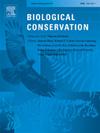Coping with ocean dynamics: Foraging strategy and implications for conservation of a small petrel
IF 4.9
1区 环境科学与生态学
Q1 BIODIVERSITY CONSERVATION
引用次数: 0
Abstract
Seabirds' distribution is generally influenced by the ecological dynamics of marine environments. Understanding how oceanographic features shape seabird foraging behaviour remains a challenge. We combined GPS tracking locations (n = 2883) of 39 European Storm-petrels (Hydrobates pelagicus) breeding in four West Mediterranean colonies during incubation over multiple years (2019–2021) with near-real-time remotely sensed oceanographic drivers. We model habitat selection using GPS tracking data from one colony, Benidorm Island, and use data from other three colonies for validation. We show that suitable foraging areas are strongly characterized by low sea surface temperature, high chlorophyll concentration and eddy kinetic energy. Based on this model, we predict habitat suitability maps for 2018–2022. Cross-validation using data from the other three colonies highlights that the identified suitable areas are universally applicable across other Storm-petrel colonies in the Western Mediterranean. We identified the Alboran Sea, the North African coast, the Gulf of Lion and the Ebro River Delta as the most suitable regions. These areas are characterized by high mesoscale variability, suggesting the importance of dynamic oceanographic features in determining foraging habitat. Identified main foraging areas are largely outside of Marine Protected Areas (MPAs), thus vulnerable to anthropogenic threats such as overfishing and energy infrastructure development. The critical foraging areas identified for this species underscore the need to expand the MPA network and/or adopt sustainable resource extraction in unprotected marine areas.
求助全文
约1分钟内获得全文
求助全文
来源期刊

Biological Conservation
环境科学-环境科学
CiteScore
10.20
自引率
3.40%
发文量
295
审稿时长
61 days
期刊介绍:
Biological Conservation is an international leading journal in the discipline of conservation biology. The journal publishes articles spanning a diverse range of fields that contribute to the biological, sociological, and economic dimensions of conservation and natural resource management. The primary aim of Biological Conservation is the publication of high-quality papers that advance the science and practice of conservation, or which demonstrate the application of conservation principles for natural resource management and policy. Therefore it will be of interest to a broad international readership.
 求助内容:
求助内容: 应助结果提醒方式:
应助结果提醒方式:


